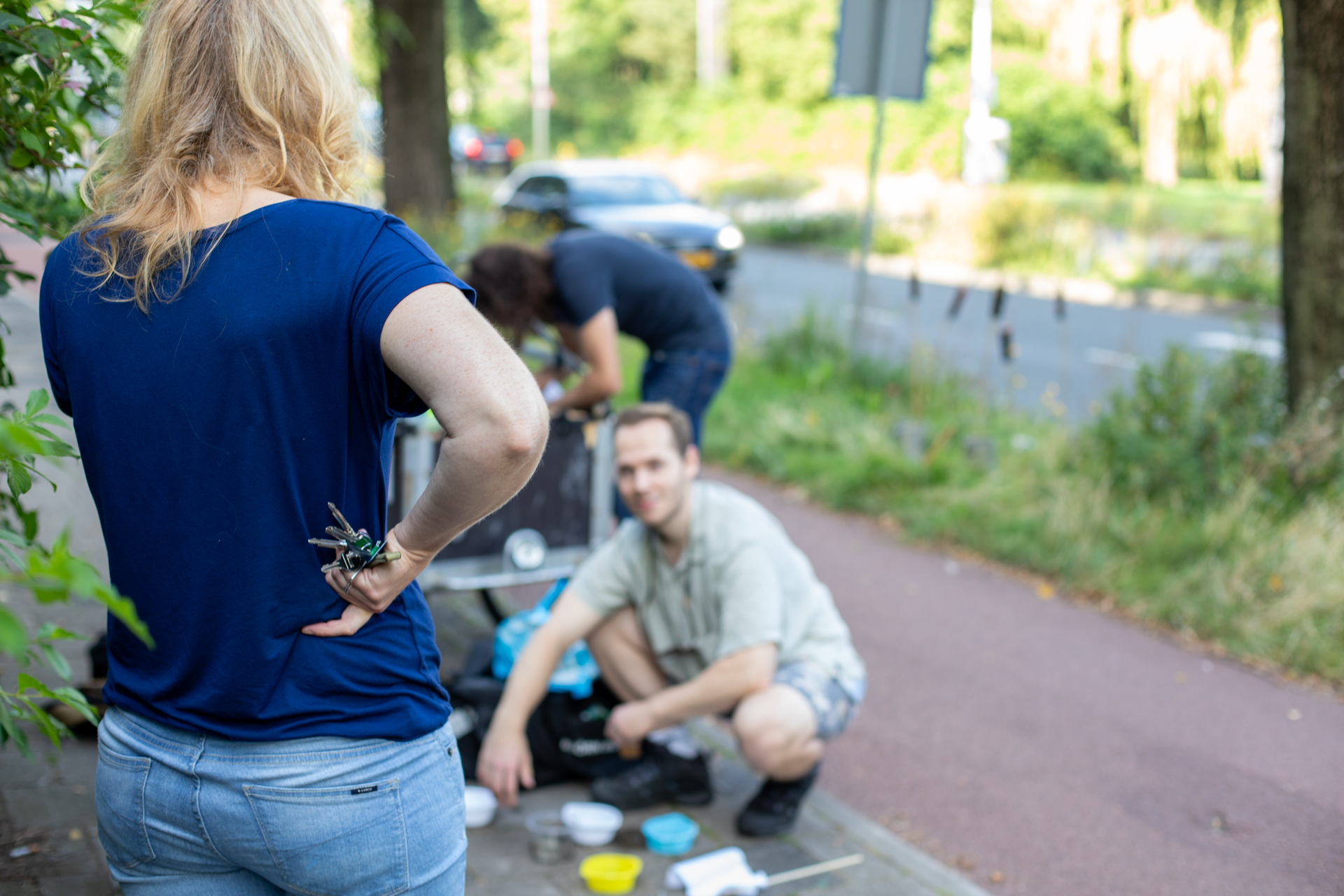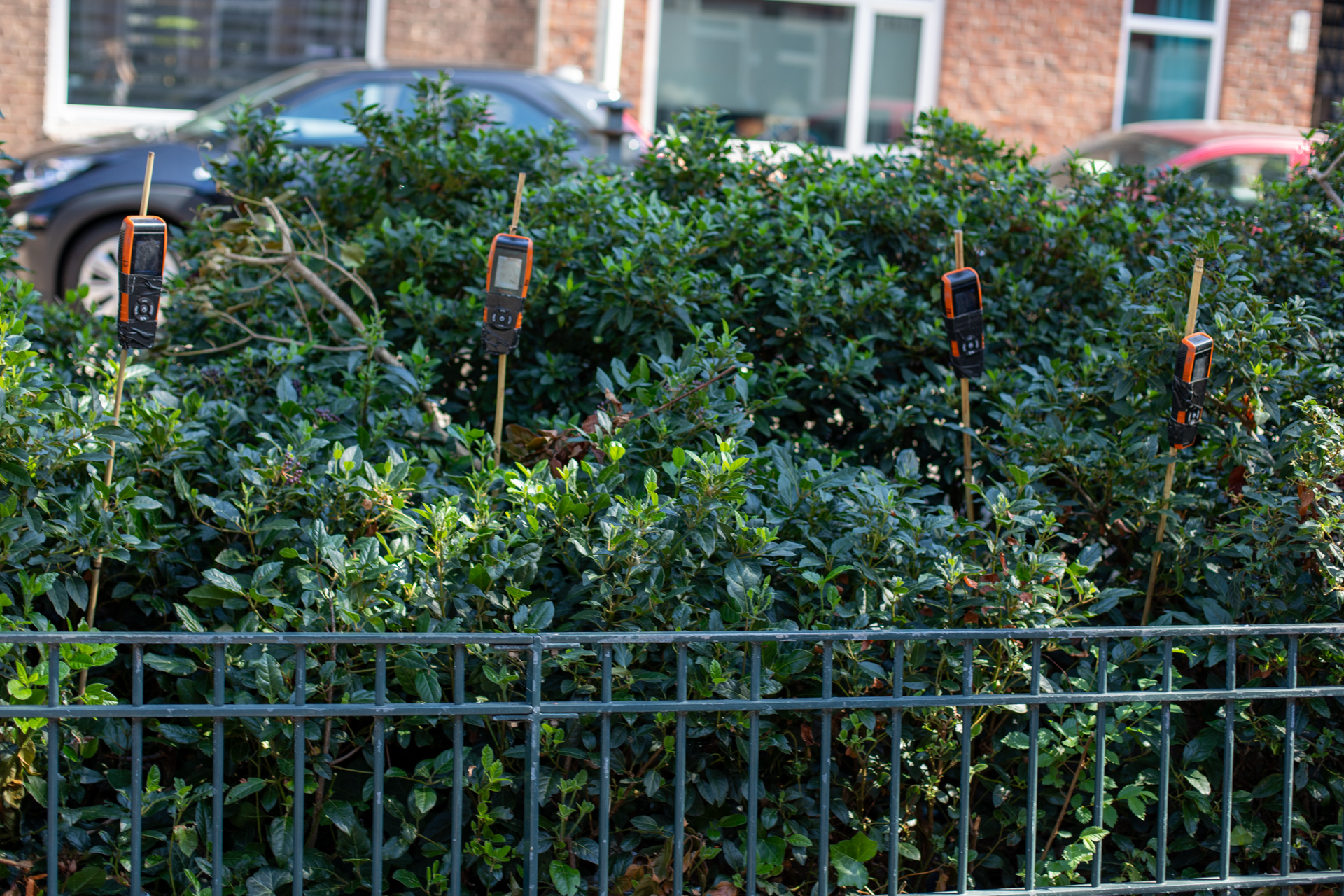
Report: Tracking down green spaces in The Hague in places you don't always want to be
Although there is considerable evidence that nature in the city is beneficial to both people and animals, we still do not have an overall picture of those benefits. To rectify that, a Leiden PhD candidate and a student – armed with a cargo bike – are using The Hague as a life-size laboratory.

It’s a Wednesday morning in August in The Hague. As the fog slowly loosens its grip on the Hoftoren, PhD candidate Joeri Morpurgo steps into a dark, concrete bicycle shed. A fluorescent light flickers on to reveal a battered cargo bike tucked away in a corner. It’s loaded to the brim with containers, cylinders and sticks. The bike, which is on the verge of retirement, has been a faithful servant to Joeri and his master’s student Orestis Strymponis. ‘The other day the wheel came off in the middle of the cycle path,’ says Joeri with a grin. ‘And you have to brake carefully, or the saddle will shoot up and you’ll fly over the handlebars.’

We grab a few things from the lab and set off on our way. A convoy of a cargo bike, a folding bike and two public transport bikes is touring the city today, taking measurements of The Hague’s green spaces in unexpected – and sometimes not-so-pleasant – places. Joeri already has two years of ‘field research in the city’ under his belt, and Orestis joined him last year. We, a reporter and a photographer, are tagging along with them on one of the last days of their study.

Location 1: Segbroeklaan 436, Segbroek
Anyone who thinks that fieldwork in the city isn’t dangerous can think again. On Segbroeklaan, not far from the beach, lorries, motorbikes and cyclists race back and forth along the verge. The day before yesterday, Joeri set up insect traps near a tree at number 436: coloured containers with water and a drop of soap to help them float. Insects flock to the containers because they look like flowers. Joeri inspects the contents and spots, among other things, a springtail. ‘I’ve noticed that they’re much bigger in the city.’ He is concerned about the lack of insects in the containers. ‘Not a great catch,’ he grumbles. But moments later he lets out a cry of joy: he had overlooked a large beetle. ‘Wow, look at the size of that! I have no idea what it is.’
A local resident emerges from her front door and points to the bamboo sticks with sensors that Orestis has planted in the ground. ‘What are you doing?’ she asks curiously. For a second, she thought we were setting up flares. After Joeri explains that one of the things they are measuring is air quality, she is very curious to hear about the results. ‘So what’s the air quality like?’ she asks, nodding in the direction of the motorway. Orestis checks the sensors. ‘Twenty,’ he replies. ‘Is that good or bad?’ she asks. ‘It’s not what’d you call healthy,’ Joeri says apologetically. ‘In The Hague, a reading of between 2 and 8 is normal, and anything above 25 starts to get unhealthy.’ ‘Could you pop one of those sensors in my garden?’ asks the woman. Alas, Joeri has to take all the instruments with him.
Measurement results:
Temperature = 21.7 °C
Humidity = 69%
Presence of particulate matter according to WHO standards: too high (PM2.5 = 14.3, PM10 = 24.4)
Presence of formaldehyde and organic substances: safe (TVOC = 0.10, HCHO = 0.025)
Audio in Dutch: What exactly is Joeri investigating and why?

Location 2: Valkenboskade, Segbroek
A dilapidated stool with an earthenware pot on top stands under a giant beech tree on the edge of a car park. The measurements are supposed to tell the real story about this spot, of course, but like any true nature detective, Joeri makes some quick observations. ‘There’s no green at all near this tree, so people must tend to this patch of land. Or it could be that drivers park badly and drive over the ground with their wheels. Or it might be because this huge tree sucks up a lot of water. There’s very little moisture in the soil. Can you see that yellow layer? The water goes right through that and into the layer below.’ It really is bone-dry here, as the reporter discovers when he is allowed to hammer a cylinder into the ground himself; you really have to ram it with all your might to make sure it’s secure.
The neighbourhood is rustic and green, and while measuring we spot a jay with its young, pigeons, a grasshopper and several beetles. Biodiversity seems to be doing well here. But we also come head to head with the other side of nature: the pavement is covered in large turds, which makes the digging slightly less fun.
Measurement results:
Temperature = 22.8 °C
Humidity = 62%
Presence of particulate matter according to WHO standards: safe (PM2.5 = 4.1, PM10 = 7)
Presence of formaldehyde and organic substances: safe (TVOC = 0.10, HCHO = 0.025)
Would you like to visit these locations in The Hague yourself?

Location 3: Tienhovenselaan, Oostbroek-Noord
‘There are definitely far fewer insects than there were last year,’ says Joeri as he inspects the insect traps. ‘There are ridiculously few.’ Among the rubbish bins, the reporter learns how to empty one of these traps. You take a coffee filter and pour the soapy water and the insects into it (making sure that you hold on tightly to the corners, otherwise it will overflow, and you will have to start all over again). Then you take the filter by the corners and carefully twist it into a kind of bag to get the last drops out. Now comes the trickiest part: scraping the insects off the filter and into a tube. Then you add alcohol to the tube, and they are ready to be taken to the lab. This particular tube contains a remarkable number of tiny wasps.
Audio in Dutch: how does Joeri hope his research will help citizens and policy makers?
In a few days, Joeri and Orestis’ fieldwork will come to an end. A much nicer location than the dustbins awaits them this afternoon; they will finish the day in the Zuiderpark. Then they will head to the lab to process all the data and start to answer that all-important question: how does urban greenery actually benefit people and nature? ‘So that we can all make more conscious choices about the kind of greenery we put in the city,’ explains Joeri. ‘And protect both nature and people.’
Measurement results:
Temperature = 23.6 °C
Humidity = 57%
Presence of particulate matter according to WHO standards: safe (PM2.5 = 3.1, PM10 = 5.1)
Presence of formaldehyde and organic substances: safe (TVOC = 0.10, HCHO = 0.025)
Text: Jan Joost Aten
Photography: Rob Dorresteijn
The research: what can be done with urban green spaces?
increased biodiversity. But the problem is that we still know very little about it. How do urban green spaces benefit people? And how do they benefit nature? There was only one way to find out: research on the ground. And so Joeri Morpurgo and Orestis Strymponis are carrying out all kinds of measurements at 207 locations throughout The Hague (an average of five locations per day). In this respect, The Hague is a mega testing ground; ideally, it should be possible to replicate the research in cities all over the world. Based on the measurements, Joeri hopes to be able to draw conclusions about the specific effects of urban green spaces on people and animals. They are measuring:
- Air quality, using sensors. The sensors are attached to bamboo sticks and planted in the ground.
- Biodiversity, by setting up traps and scooping up soil near the traps. The insects caught in the traps are then taken to the lab for DNA analysis to determine their exact species.
- Water infiltration (i.e., how quickly water is absorbed by the soil). This is useful to know in the event of heavy rainfall or flooding. To measure this, metal pipes are placed in the ground and water is poured into them. A stopwatch is used to see how long it takes for the soil to absorb the water.
- Composition and density of the soil. A small cylinder is driven into the soil with a rubber hammer, and the soil sample obtained is taken to the lab.
- Temperature and humidity of the air and soil.
- The release of CO2 from the soil. This is done by placing a dark, closed cylinder on the ground, which ‘captures’ carbon dioxide from the soil. Using a needle, some air is sucked out of the cylinder at the beginning and after half an hour and put into a tube. The amount of carbon can then be measured in the lab.
The first results of the study are expected in 2024.
-

Segbroeklaan - A resident comes to check out what's going on -

Segbroeklaan - Joeri inspects the contents of the traps -

Valkenboskade - The neighbourhood police officer is also interested in the activities -

Tienhovensekade - Air quality sensors sometimes have to be fitted into the tightest spots -

Tienhovensekade - Getting insects into coffee filter is a fiddly job
